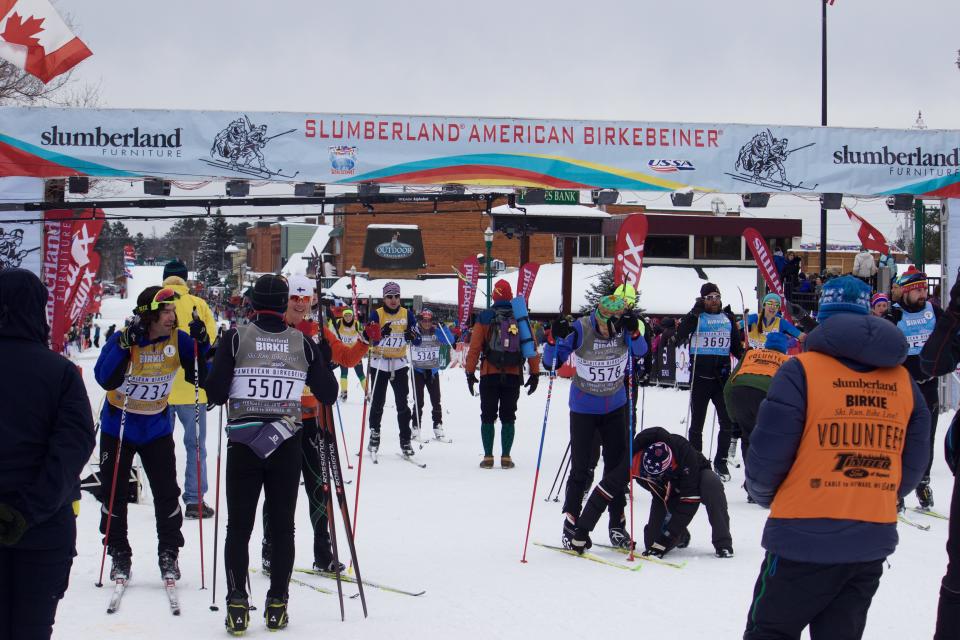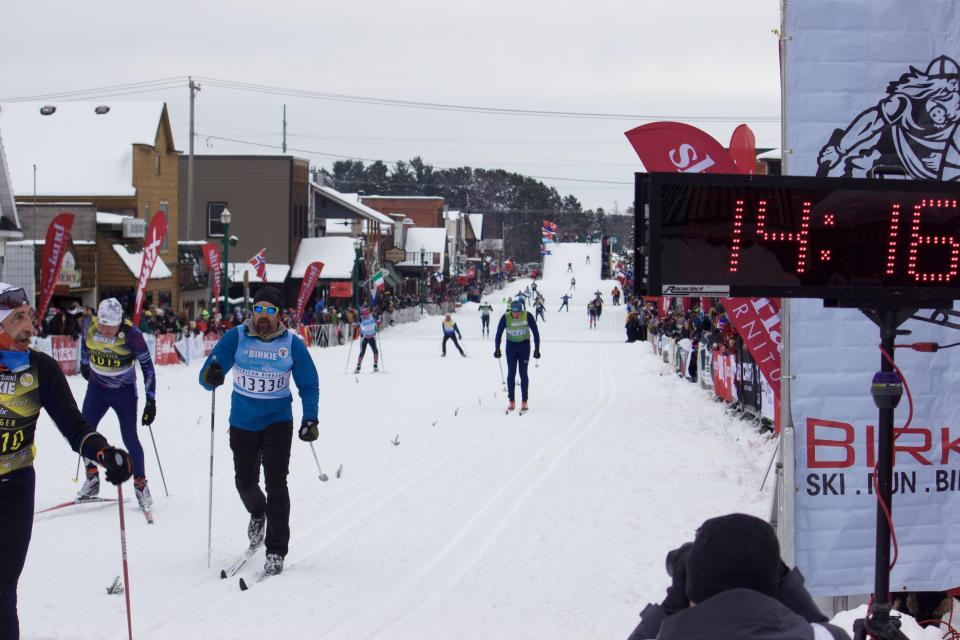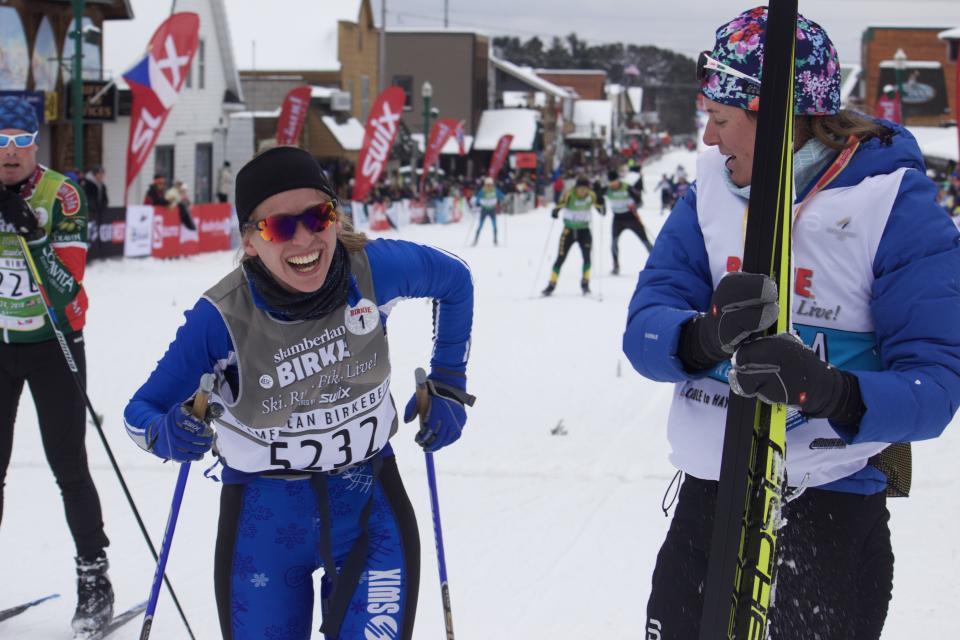The Day We Met We Made a Pact to Finish a 50K Ski Race Together and We Actually Did It
At 8:30 A.M. on February 24 in Cable, Wisconsin, we find ourselves sprinting through a sea of Spandex and ski poles. The American Birkebeiner 50K cross-country ski race starts in 10 minutes. We meant to be here half an hour ago, but a rookie timing miscalculation—and one missing pair of skis—left us scrambling.
There are 5,388 people toeing the start line today, and everyone is in a frenzy—waiting impatiently for portable toilets, slurping last-minute gels, shedding layers, filling drop-bags, bouncing around to keep warm on this 10-degree morning. By the time we toss our gear bags into the trucks that will meet us at the finish line, the first wave of skiers is already waiting in the start pen.
“Good luck!” we yell to each other, and then head to our respective start groups. Thirty seconds later, the gun goes off.
The American Birkebeiner may just be the country’s biggest athletic event that no one has ever heard of.
Every year, over 13,000 skiers flock to the Northwoods of Wisconsin for Birkie Weekend, which includes eight races ranging in distance from 50K to 1/2K. More than a third of those skiers come to make the full 50K (a little over 31 miles) pilgrimage from Cable to Hayward. The race has been around since 1973, and is inspired by the ski tradition brought to the Midwest by Scandinavian immigrants. Over the last 44 years, the American “Birkie” has become the linchpin of U.S. endurance ski culture—a cult classic that many return to year after year. This year the energy was higher than usual: The race fell just one week after Kikkan Randall and Jessie Diggins had claimed Olympic gold in the skate team sprint, the first time the U.S. had earned an Olympic medal in cross-country skiing since 1976.
For the small towns of Cable (population 204) and Hayward (population 2,317), Birkie weekend is the single biggest of the year. Between racers, family members, volunteers and spectators, more than 40,000 people participate. Race organizers truck snow into downtown Hayward and turn Main Street into a ski trail. Fans line the sidewalk to cheer racers to the finish, a strange hodgepodge of Lycra, camo, and everything in between.

After meeting by chance, we decided to train for it “together” from across the country.
We are an unlikely duo in an odd world: Annie, a former professional cross-country ski racer, who, a year ago, was training and racing alongside Olympic gold medalists Diggins and Randall; Ariella, a recreational skier who was 12 years old (and wearing fleece pants) the last time she entered a cross-country ski race.
Six months ago, we met by chance at a trail-running race. We discovered a mutual love of cross-country skiing—which, prior to this year’s Olympics, was not particularly common—and became fast friends. Two days later, we parted ways with a plan to ski the American Birkebeiner.
Plans like this often fall through. In fact, ours almost did—several times.
For starters, we were training nearly 1,000 miles apart—Ariella in western Colorado, and Annie in central Idaho. Instead of group runs and gym sessions, we had brief phone calls and rambling text chains. Then there was the issue of snow—or lack thereof. This winter was the west’s worst (least snowy) on record in more than 30 years.
Ariella: I’ve been skiing since I could walk, and dreaming of skiing the Birkie since high school, so I signed up for the race with little debate. But when January rolled around and western Colorado still didn’t have enough snow to ski on, I realized I had gotten in over my head. My passion for outdoor endurance sports has always outmatched my actual fitness. I’m naturally unathletic, and I hate training. I’d much rather go for a slow, meandering run than do interval workouts or hill repeats.
Thankfully, I had Annie to answer all one million of my questions, most importantly: “We still have zero snow in Colorado. What am I supposed to do?” She asked me if I had ever been ski bounding. Ski what?
“It’s basically really inefficient running with poles--but it’s the best way to target a lot of ski-specific arm and core muscles. There’s a video of the U.S. Ski Team bounding. I think I’m in it. I’ll send it to you.”
The next afternoon, I headed up a steep dirt road just outside town, with my running shoes and a pair of old ski poles, and attempted to mimic Annie’s long, loping strides and purposeful pole plants. I felt like an adolescent giraffe. The next day, everything hurt.
Over time I got into a routine: run, bound, complete strength and core workouts, send panicked texts to Annie involving phrases like “How do I …?” “Do you usually …?” and “WTF are we getting ourselves into?”
When I got a new job and had to move to a different state, all semblances of a training plan flew out the window. I probably would have backed out of the race altogether had it not been for Annie’s constant reassurance. As the race drew closer, that reassurance turned to commiseration.

Annie: When it came time for race sign up, pride was my vice. I had trained my entire life as an elite racer, and the thought of skiing without training full time terrified me. I didn’t understand entering a race that I couldn’t win. After a lifetime of prioritizing exercise over everything else in my life, fitting training into a full-time work/love/social schedule felt like one of the hardest things I’d ever done. Sometimes I couldn’t even bear to get out on my skis.
But then, there was Ariella. This chick was bouncing up and down to enter a race in one of the hardest endurance sports on the planet with little-to-no specific training. That energy reignited a feeling I’d only ever had with my former teammates: win or lose, we’re in it together.
Our training conversations became almost constant. But neither of us let on that we thought about quitting.
But on February 24, we got ourselves to the start line feeling excited, bewildered, and more than a little apprehensive. Ariella started the race a few waves back from Annie, which meant that just as we had trained apart, we would also race apart.
Annie / Start (9:05 A.M.): This is my first-ever race where I’m not competing for the win. I definitely did not have time to go to the bathroom. This will be a physical and emotional journey, but at least I have fast skis.
Ariella / Waiting for Wave 5 start (9:15 A.M.): My toes are numb. I lean on a fence, take off my boot and try to stick my foot in my armpit to warm it up. The act is both strange and totally normal in this environment.
Ariella / Start (9:45 A.M.): I enter the start pen along with several hundred other skiers. Someone fires up a megaphone and starts counting down from 30. A gun goes off, and everyone starts to move.
Annie/10K (9:56 A.M.): I hear the pit-pit of poles and the squeaking of skis against the snow bookended by heavy breathing of other skiers at different levels of discomfort. A competitive fire urges me to light it up and toast these suckers. The less-competitive person I’m trying to become suggests that I instead have a snack. Begrudgingly, I listen to the latter voice.
Ariella / 5K (10:10 A.M.): After over an hour of standing around nervous and freezing, I’m relieved to fall into the familiar side-to-side gliding motion of skate skiing. My body knows what to do. The sight of hundreds of other cross-country skiers bobbing ahead into the distance—more than I’ve ever seen before in one place—briefly takes my breath away. I feel at home.
Annie / 30K (11:00 A.M.): All of the people I am skiing with are men. I see only two or three other women in the first wave with me. A couple of guys get into a tangle on a hill and begin cursing each other. I fire past them and fume about how they are taking themselves too seriously. It occurs to me that maybe I had been doing the same. I now have 20K to calm down, have fun, enjoy this experience.
Ariella / 10K (11:04 A.M.): I’m finally starting to warm up. I skate to the edge of the trail and take the hand warmers out of my gloves. A man skis by wearing split shorts and a cape.
Annie / 40K (11:30 A.M.): With about 10K to go, I decide to skip the final aid station and go straight to the final big hills before heading onto the long flats sections that bring us into the Hayward finish line. I feel good, excited, and in love with the sport I decided to leave almost exactly a year ago.
Annie / 42K (11:35 A.M.): System overload. Should not have skipped feed station.
Ariella / 15K (11:25 A.M.): The first 15 kilometers have flown by in a blur of gridlocked uphills, cruisy downhills, and fantastic people-watching. I see a woman skiing in a silver tutu, a man skiing in a felt turkey costume, and another in a lumberjack-plaid Spandex onesie. This is helpful in distracting me from the realization that we are only less than one third done, with 35 kilometers left go, which is still further than I’ve ever skied.
Annie/ 47K (11:59 A.M.): People are lining the groomed trail on the frozen Lake Hayward cheering us through. I see a sign that says “Finish like you’re Jessie Diggins going for gold.” I think of Jess, my former roommate, former teammate, and lifelong hero and all she has given to this sport. I think of the ways I can continue to contribute, continue to be involved with the community that shaped me. It all starts with this finish.
Ariella / 20K (12:01 P.M.): At the third aid station, the loudspeaker is blasting “Hot Hot Hot” and I start bopping while eating a piece of banana.
Annie/ 49.99 K (12:09 P.M.): Faceplant. I trip over my own pole just feet from the finish line and crash hard into the slushy snow. This proves to be my final test of humility. I laugh, wipe the snow off my face, and wiggle across the finish line to the cheers of the spectators and my former teammates. As I cross, I enter a new athletic phase of my life, and I couldn’t be happier to be here.
Ariella / 25K (12:30 P.M.): Happy to have reached the halfway point, I celebrate with a Stroopwaffel and a packet of chews. The trail starts to flatten out a bit, and for the first time, I know that I will finish.
Annie / (looking up Ariella’s place on course): Food. Need food.
Ariella / 30K (1:00 P.M.): Having eaten too much too fast, I now feel bloated and nauseated. I contemplate using the portable toilet at aid station number five, but decide that if I stop, I might not start again. The finish suddenly seems very far away. I sing “Hot Hot Hot” in my head as a distraction.
Annie/ post finish: Water. Need water.
Ariella / 35K (1:20 P.M.): A crowd of snowmobilers has gathered along a particularly steep, windy downhill. They hoot and holler as skiers fly around the corner. I focus all of my energy on staying upright. Cheers erupt, followed by “oooh” as a skier behind me takes a diving faceplant. He picks himself up, his beard covered in snow, waves to his fans, and keeps on skiing.
Annie/ Post finish: Beer. Find Beer.
Ariella / 40K (1:50 P.M.): Aid station number six. My stomach has settled. Orange slices are the best thing I have tasted, ever.
Annie/ post finish: My athlete tracker tells me that Ariella should arrive in the next 20 minutes. I make my way to the finish line and watch in awe as one or two skiers crosses the line each second.
Ariella / 41K (1:55 P.M.): Single digits! I am basically at the finish. Time to stop worrying about calories and electrolytes and just enjoy these last kilometers.
Ariella / 42K (2:08 P.M.): Spoke too soon. Debilitating quad cramp. I double over. “Is it a bad one?” a fellow skier nods my way. “Yep,” I respond. “Same thing just happened to me,” he says, sympathetically. I tear open my waist pack and down a gel and half of my bottle of electrolyte mix.
Annie: Uh oh, her times are slowing down.
Ariella / 45K (2:25 P.M.): Everything is painful and slow. My right quad keeps shaking uncontrollably. I down another gel and more electrolyte mix. People pass me and glance over with concern.
Annie: Watching Ariella’s tracker paused at 8K to finish, I fear for the worst. She’s going to hate the sport, this idea, and me for getting her here. Please, ski gods, let me see her crest the finish area soon.
Ariella / 48K (2:40 P.M.): The course emerges onto a frozen lake. People have dragged out lawn chairs, blankets and coolers. They clap and cheer as we limp past. My triceps are seizing up now, and I begin planning how I will alert the finish-line medics to the fact that I am on the verge of implosion.
Annie: Finishers continue to pour in, and I keep checking my app to make sure that I haven’t missed Ariella. This feels distinctly like the races I’ve had all over the world, where we wait for our teammates in the finish pen. By now, I’ve informed all of the finish volunteers and race officials of our journey together, and they, too, have been searching for the skier in blue.
Ariella / Finish (2:50 P.M.): At the edge of the lake, the trail cuts left into downtown Hayward. The crowd starts to grow, and I attempt to muster some semblance of form. From the top of the bridge, I look down straight ahead to the finish line four blocks away. I try to take it all in—the spectacle of skiing down Main Street in a tiny town in Wisconsin, with thousands of people cheering and ringing cowbells. I search the faces, wondering if Annie is somewhere among them.
Annie: The entire finish area erupts when we see Ariella crest the bridge into the finish.
Ariella: I hear someone shouting my name, and look up in time to see Annie jumping up and down just over the finish line. I ski into her without stopping, and immediately realize that I’m going to be fine. “Holy shit!,” I yell. “We just skied the Birkie!”


